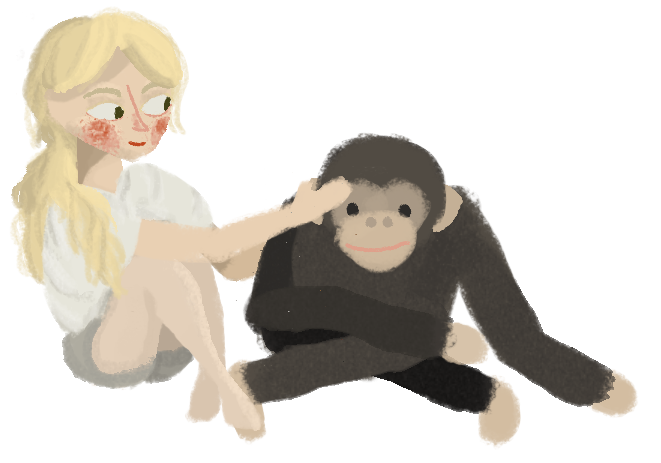
Jane Goodall
is a world expert on chimpanzees. She is a british primatologist, ethologist, anthropologist, UN messenger of Peace, and a member of the board of nonhuman rights project since its founding in 1996.

Her fondness for animals was clear very eary on in her life. She once hid in a henhouse watching hens lays eggs for so long that her family reported her missing to the police. She also writes in her book, Reason for Hope, "My father gave me a lifelike chimpanzee doll. My mother;s friends were horrided by this toy, thinking it would frighten me and give me nightmare. My doll, Jubilee, still sits on my chair in London"

Jane couldn’t afford to go to college. So she worked. When she was 22, she got invited by her friend Clo to come stay on her family’s new farm in Kenya.
She set sail in 1957 and arrived in Mombasa on April 2nd. A few weeks afterwards, she meets Louis B. Leakey. He is a famous archaeologist and paleontologist who was interested in studying about evolution. He was impressed by Jane's energy, interest, and knowledge in animals. He hired her as his assistant and eventually helping him and his anthropologist wife, Mary Leakey, dig up fossils in the Olduvai Gorge.

At that time, Leakey was looking for someone to go to Tanzania to study chimpanzees. Studying them would be fascinating and might provide clues about evolution. Louis offers this chance to Jane and she agrees.
The British authories thought it was too dangerous for a young woman to be living alone in Tanzania alone. Jane compromises and brings her mother along for a few months.

Research
Jane's biggest contribution to science was her obersevation disproving 2 long-standing beliefs:
1) that only humans could construct and use tools
2) that chimpanzees were vegetarians.
Dr. Goodall's discovery in 1960 that chimpanzees make and use tools is considered one of the greatest achievements of the twentieth-century. Until that moment, scientists had thought only humans made tools. In fact, that’s one way scientists defined homo sapiens -- as "man, the toolmaker." By her discovery, the scientific world had to define what it meant to be human.

As she wasn't dictated by traditional scientific training, she conducted her research using unorthodox methods. Her most known was that she named her apes rather than numbering them. These included:
David Greybeard - a grey-chinned male who first warmed up to Jane. He was the one that Jane observed making tools to "fish" for termites
Goliath - a friend of David Greybeard, who used to be the alpha male of the clan
Mike - who displaced Goliath through his cunning plans
Humprey - a male bully
Gigi - a sterile female who was delighted to be any young chimps' or humans' "aunt"
Mr. McGregor - an aggressive older man
Flo - a matriach of the 'F' clan. Her children were Figan, Faben, Freud, Frodo, Fifi, and Flint
Frodo - Flo's second oldest child who frequently attacked Jane and ultimately forced her to leave the
Her close bond to the apes led her to become the only human ever accepted into chimpanzee society

Jane discovered that a chimp's life wasn't always peaceful. Sucession of alphas caused much drama. Some females kill other chimp's babies. There was even a four-year "war" during 1974. But these violent moments were accompanied by touching moments. Chimpanzees offer each other hugs, kisses, tickles, and pats on the back.

Legacy
Jane Goodall's work transformed the way we understand the relationship of humans and animals. She is the first member of the "Trimates", the founding mothers of Primatology, who include Dian Fossey and Birtue Galdikas. Her pioneering work in Tanzania broke gender norms and led the way for many other female scientist to be able to work in exotic locations. She revolutionary work showed that, provided the opportunity, anyone can make vanguard discoveries.
Sources:
- Jane Goodall - What seperates us from apes
- Janegoodall.org/
- Goodall, Jane; Phillip Berman (2000).
Reason for Hope: a spiritual journey. New York: Warner Books. p. 4.
ISBN 978-0-446-67613-7. - NYTimes - Jane Goodall is still Wild at Heart